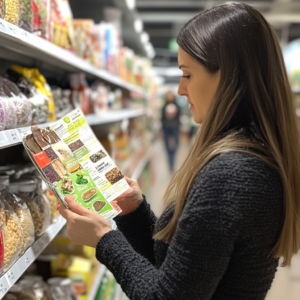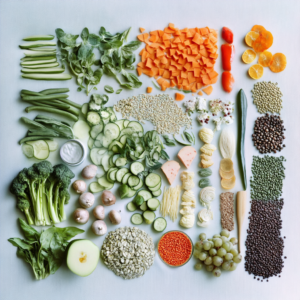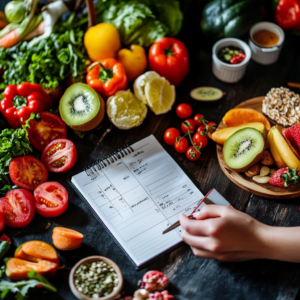Introduction
Welcome, fellow health enthusiasts! In this comprehensive guide on How to Read Nutrition Labels as a Vegan Shopper, I invite you to explore a detailed approach to making informed dietary decisions that align with your vegan lifestyle. My personal journey has taught me that understanding nutrition labels is not only essential for avoiding hidden animal-derived ingredients but also for selecting products that support my overall health and ethical values. Throughout this article, you will find practical tips, personal insights, and expert advice to help you confidently navigate the supermarket and make choices that nourish your body while upholding your vegan principles. If you’re interested in further exploring plant-based nutrition, I recommend checking out 10 Essential Vegan Nutrition Tips for a Healthier Life.
Understanding How to Read Vegan Nutrition Labels
In this section, I explain the core concepts behind reading nutrition labels on vegan products. Grasping these concepts gives you the power to determine whether a product truly meets your nutritional and ethical standards. Over time, this skill has transformed my shopping habits, ensuring that each purchase contributes positively to a sustainable, healthy vegan diet.

1. The Importance of Reading Nutrition Labels for Vegans
For me, every food purchase is a deliberate and conscious decision that reflects my commitment to ethical living and optimal health. Nutrition labels are indispensable tools that reveal detailed information about a product’s nutritional content—including calories, macronutrients, micronutrients, and a complete list of ingredients. This information is crucial for identifying hidden animal-derived components and ensuring that the product fully aligns with my vegan lifestyle.
a. The Role of Nutrition Labels in Making Informed Vegan Choices
Nutrition labels serve as a transparent window into the composition of the foods we consume. They provide clarity on what each product contains and in what quantity. For example, a quick scan of the ingredients list can alert you to the presence of dairy derivatives like whey or casein, which may be hidden under ambiguous terms such as “natural flavors.” Such vigilance has allowed me to steer clear of products that compromise my vegan values and focus on those that contribute to my nutritional well-being.
b. Empowering Your Diet Through Knowledge of Nutrition Labels
Armed with the knowledge gleaned from nutrition labels, I am able to tailor my diet to my specific health needs. In my early days as a vegan, the plethora of choices in the supermarket was overwhelming. However, as I learned to decode these labels, I became adept at comparing products and selecting those with superior nutritional profiles. This expertise has empowered me to make choices that enhance my energy levels and overall health, ensuring that my diet remains balanced and true to my ethical standards.
2. Key Components of a Vegan Nutrition Label
To fully harness the benefits of nutrition labels, it’s essential to understand each of their components. I will break down the most important sections and explain how they relate specifically to vegan products.
a. Serving Size and Caloric Information
The very first element you encounter on a nutrition label is the serving size, which indicates the quantity of the product that the nutritional facts refer to. Caloric information is tied to this serving size, making it critical to manage your overall energy intake. For instance, a product may list low calories per serving, but if multiple servings are consumed, the total caloric intake could be much higher. Keeping an eye on serving sizes has helped me control my portion sizes and maintain my dietary goals.
b. Macronutrients: Carbohydrates, Proteins, and Fats
Nutrition labels provide a detailed breakdown of macronutrients—carbohydrates, proteins, and fats. These values are essential for understanding how a food item will impact your energy levels and support bodily functions. As a vegan, I pay particular attention to the protein content to ensure that I’m meeting my daily requirements through plant-based sources. Additionally, I examine the type of fats present, preferring those that are unsaturated and beneficial for heart health. This detailed information allows me to select products that contribute to a balanced and sustainable vegan diet.
c. Micronutrients: Vitamins, Minerals, and Other Essential Nutrients
Micronutrients play a vital role in overall health despite being required in smaller quantities than macronutrients. Nutrition labels list various vitamins and minerals—such as vitamin A, vitamin C, calcium, iron, and sometimes vitamin D—that are crucial for maintaining good health. For vegans, this section is particularly important because some micronutrients (notably vitamin B12 and vitamin D) can be scarce in a plant-based diet. Understanding these values helps me decide if a product is fortified or if additional supplementation is needed.
d. The Ingredients List: Spotting Hidden Animal-Derived Components
The ingredients list is arguably the most critical section for vegan shoppers. It details every component of the product in descending order by weight. I scrutinize this list for any hidden animal-derived ingredients, such as casein, whey, gelatin, or even certain enzymes and colorings. This careful review ensures that the products I choose are fully aligned with my vegan values. Learning to identify these ingredients has been fundamental in maintaining the integrity of my diet.
e. Allergen Information and Vegan Certification Seals
Nutrition labels often include allergen information and, in many cases, certification seals such as “Certified Vegan.” These seals provide quick assurance that the product does not contain any animal-derived ingredients. This additional layer of verification simplifies my shopping experience by allowing me to quickly identify products that meet both my nutritional and ethical standards.
3. Strategies for Interpreting Vegan Nutrition Labels
With an understanding of the key components in place, the next step is applying practical strategies to interpret nutrition labels effectively. Over the years, I have developed several techniques that have proven invaluable in my journey as a vegan shopper.
a. Identifying Hidden Animal-Derived Ingredients
One of the biggest challenges is spotting ingredients that might be derived from animals. I keep a mental list—and sometimes a physical note—of common non-vegan additives such as whey, casein, gelatin, and certain enzymes. This habit allows me to quickly assess whether a product truly meets my vegan criteria. Over time, this practice has become second nature and has significantly reduced the risk of purchasing products that contradict my dietary values.
b. Decoding Additives, Preservatives, and Artificial Flavors
Many processed foods contain additives and preservatives that are used to enhance flavor and extend shelf life. However, these additives can sometimes conflict with a natural, healthy vegan diet. I prefer products with short, natural ingredient lists and avoid those with long, complex chemical names. This approach not only helps maintain a cleaner diet but also ensures that I’m consuming products that support my overall health.
c. Comparing Similar Vegan Products for Better Nutrition
Nutrition labels are excellent tools for comparing similar products. For example, when I evaluate two brands of plant-based milk, I examine the calorie counts, protein content, sugar levels, and fortification with vitamins and minerals. This side-by-side comparison helps me choose the product that best fits my nutritional needs while adhering to my vegan values. Such comparisons have saved me money and ensured that every purchase contributes positively to my diet.

4. Practical Examples: Reading Labels on Common Vegan Foods
Now, I’d like to illustrate how these strategies come together in real-world scenarios. The following examples are drawn from my own shopping experiences and highlight how reading nutrition labels can help make informed vegan choices.
a. Plant-Based Milk and Dairy Alternatives
When shopping for plant-based milk, I always review the nutrition label for key details such as protein content, added sugars, and whether the product is fortified with calcium and vitamin D. Some almond and soy milks are fortified to mimic the nutritional benefits of dairy milk, making them excellent choices for vegans. By comparing the labels, I can determine which product offers the best nutritional value, ensuring that I get a balanced source of essential nutrients.
b. Vegan Snacks and Energy Bars
Vegan snacks, including energy bars, often consist of a mix of nuts, seeds, dried fruits, and natural sweeteners. I check the serving size and the nutritional information to ensure the product provides a healthy balance of macronutrients and fiber without excessive added sugars. Sometimes, I discover that a product contains hidden ingredients that aren’t vegan, which reinforces the importance of reading the full ingredients list. This careful scrutiny has saved me from purchasing items that would otherwise compromise my dietary standards.
c. Meat Alternatives and Processed Vegan Foods
Many meat alternatives and processed vegan products are designed to replicate the taste and texture of animal-based foods. However, these items can vary greatly in nutritional quality. When examining their labels, I focus on the protein content, sodium levels, and the overall quality of ingredients. This detailed examination helps me select products that are not only delicious but also nutritionally beneficial. By making these informed choices, I ensure that my vegan diet remains healthy and balanced.
5. Tools and Resources to Enhance Your Label-Reading Skills
To further refine your ability to decode nutrition labels, there are several tools and resources that have become invaluable in my shopping routine.
a. Mobile Apps and Online Databases
Several mobile apps are designed specifically to help vegans interpret nutrition labels quickly. Apps such as “Is It Vegan?” and “Vegan Scanner” allow you to scan product barcodes and immediately determine if the product meets vegan standards. These apps are particularly useful when you’re in a hurry, enabling you to make fast, informed decisions without extensive label analysis.
b. Official Dietary Guidelines and Scientific Research
I regularly consult reputable websites such as Nutrition.gov and PubMed to stay informed about the latest dietary guidelines and nutritional research. These sources provide evidence-based information on nutrient recommendations, which has greatly enhanced my understanding of vegan nutrition. By integrating this scientific research into my daily life, I ensure that my shopping habits are grounded in reliable data.

6. How to Use Vegan Nutrition Labels to Make Healthier Shopping Decisions
Once you master the art of reading nutrition labels, you can use this skill to make smarter shopping decisions that support both your health and ethical values.
a. Budget-Friendly Shopping Through Label Analysis
Nutrition labels are an excellent tool for budget-friendly shopping. By comparing the nutritional information of similar products, you can identify items that provide superior value without unnecessary additives. This approach has helped me avoid overpriced products that offer little nutritional benefit, allowing me to invest in items that truly contribute to my overall wellbeing.
b. Aligning Nutrition Labels with Your Personal Health Goals
Every person’s nutritional needs are unique, and nutrition labels provide the detailed information needed to tailor your diet accordingly. Whether your goal is to increase protein intake, reduce added sugars, or boost your fiber consumption, the labels give you the data to make choices that support your objectives. For example, if your focus is on increasing fiber, I look for products that list high fiber content. This personalized approach has been a game changer in helping me maintain a diet that aligns perfectly with my health goals.
7. Internal and External Resources for Further Learning About Vegan Nutrition Labels
Continued education is crucial for mastering the art of reading nutrition labels. Below, I share some of the resources that have been immensely helpful to me on this journey.
Further Reading and Research
Internal Resources:
• For foundational insights into plant-based nutrition, explore 10 Essential Vegan Nutrition Tips for a Healthier Life.
• Discover practical recipes and meal planning ideas at Quick and Delicious Vegan Recipes for Busy Weeknights.
• Learn how to shop smartly on a budget by reading Budget-Friendly Vegan Meals That Don’t Sacrifice Taste.
External Resources:
For official dietary guidelines, Nutrition.gov is an excellent resource, and PubMed offers access to a vast array of peer-reviewed research on nutrition. Additionally, a highly regarded YouTube video from a trusted channel provides practical advice and creative inspiration for interpreting nutrition labels effectively.
8. Frequently Asked Questions (FAQ) About Vegan Nutrition Labels
Common Queries Answered
Q1: Why is it important for vegans to read nutrition labels?
A1: Nutrition labels help vegans identify hidden animal-derived ingredients and ensure that products align with their ethical and nutritional standards. They offer detailed information on calories, macronutrients, micronutrients, and additives, empowering you to make choices that support your health.
Q2: What should I look for in the ingredients list?
A2: Focus on spotting hidden animal-derived ingredients, unnecessary additives, or preservatives. Look for products with simple, natural ingredient lists and verify the presence of vegan certification seals to ensure they meet your standards.
Q3: How do nutrition labels help me meet my health goals?
A3: By comparing nutritional information such as serving sizes, calorie counts, macronutrient ratios, and micronutrient levels, you can choose products that support your specific dietary needs—whether it’s boosting energy, managing weight, or increasing vitamin and mineral intake.
Q4: Are there any mobile apps that can help me read nutrition labels more efficiently?
A4: Yes, apps like “Is It Vegan?” and “Vegan Scanner” allow you to scan product barcodes to quickly determine if a product is vegan-friendly. These tools streamline the shopping process and help you make informed choices quickly.
Q5: Can reading nutrition labels help me save money?
A5: Absolutely. Understanding nutrition labels allows you to compare products, avoid items with unnecessary additives, and select foods that offer better nutritional value—all of which help you manage your grocery budget more effectively.
Q6: How can I compare similar vegan products using nutrition labels?
A6: Examine serving sizes, calorie counts, macronutrient ratios, and the quality of the ingredients. This detailed comparison enables you to select the product that best meets your nutritional needs and aligns with your ethical values.
9. Conclusion and Final Thoughts on Reading Nutrition Labels as a Vegan Shopper
In conclusion, mastering the art of reading nutrition labels is an essential skill for every vegan shopper. It empowers you to make informed, ethical, and health-conscious choices in a market where hidden ingredients and misleading claims are common. By taking the time to understand each component of a nutrition label—from serving sizes and calorie information to the complete ingredients list and allergen data—you become better equipped to navigate the grocery store and select products that truly support your vegan lifestyle and overall health.
I hope this comprehensive guide has provided you with the insights and practical strategies needed to confidently interpret nutrition labels and make smarter, more ethical choices while shopping. Every informed decision you make contributes to your overall wellbeing and helps you build a sustainable, balanced vegan diet. Embrace the journey toward becoming a more knowledgeable and empowered vegan shopper!
Thank you for taking the time to read this guide. Stay curious, stay healthy, and let your informed shopping choices pave the way for a vibrant vegan lifestyle.